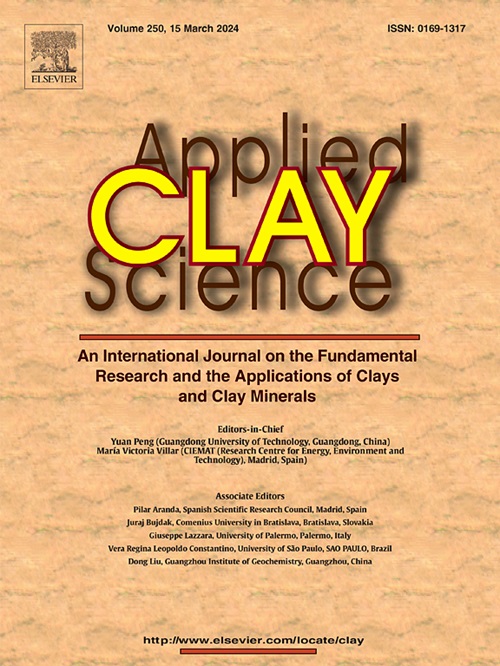高岭土纳米管促进蛋白质组装,便于制备纳米复合薄膜及其在伤口敷料中的应用
IF 5.3
2区 地球科学
Q2 CHEMISTRY, PHYSICAL
引用次数: 0
摘要
蛋白质薄膜因其无毒性、生物相容性和生物降解性,特别是在生物医学领域,为传统的合成高分子材料提供了一个很有前途的替代品。然而,由于其机械强度低、水稳定性差和生产成本高,其实际应用仍然存在挑战。本研究以负载万古霉素的高岭土纳米管(Hal)和牛血清白蛋白(BSA)为材料,制备了一种有机-无机蛋白复合膜。在复合膜中,BSA中丰富的α-螺旋结构被还原转化为富含β-薄片的相变BSA (PTB),并与负载万古霉素的Hal (VHal)通过氢键相互作用形成交联的网络结构。Hal不仅可以通过非共价相互作用增强蛋白质的自组装,提高蛋白质膜的机械强度和稳定性,还可以作为抗菌剂的载体,实现药物的持续释放系统。结果表明,制备的VHal/PTB复合膜可在30 min内完全杀灭金黄色葡萄球菌,并具有良好的生物相容性。体内研究进一步表明,复合膜能有效抑制细菌感染,加速小鼠皮肤感染创面愈合,创面在12天内接近完全愈合。这种具有抗菌性能的坚固、透气和生物相容性的纳米复合蛋白膜的设计策略为开发用于感染伤口组织的多功能伤口敷料提供了新的思路。本文章由计算机程序翻译,如有差异,请以英文原文为准。
Halloysite nanotubes potentiate protein assembly for facile fabrication of nanocomposite thin film and its application in wound dressing
Protein films offer a promising alternative to traditional synthetic polymer materials because of their nontoxicity, biocompatibility and biodegradability, particularly in the biomedical field. However, their practical use has remained a challenge due to their low mechanical strength, poor aqueous stability and high production costs. In this work, we prepared an organic-inorganic protein-based composite film by incorporating vancomycin-loaded halloysite nanotubes (Hal) and bovine serum albumin (BSA) with a facile and biocompatible method. In the composite film, the abundant α-helix structure in BSA was reduced and transformed into a β-sheet-rich phase-transition BSA (PTB), which then interacted with vancomycin-loaded Hal (VHal) through hydrogen bonding to form a cross-linked network structure. Hal can not only reinforce the protein self-assembly via noncovalent interactions to improve the mechanical strength and stability of the protein film, but also act as carriers of antibacterial agents for a sustained drug release system. As a result, the resultant VHal/PTB composite film could completely eliminate Staphylococcus aureus within 30 min and demonstrated excellent biocompatibility. In vivo studies further showed that the composite film could effectively inhibit bacterial infections and accelerate the healing of infected skin wounds in mouse skin, with near-complete wound closure achieved within 12 days. The design strategy of this robust, breathable and biocompatible nanocomposite protein film with antibacterial properties sheds new light on the development of multifunctional wound dressings for infected wound tissue.
求助全文
通过发布文献求助,成功后即可免费获取论文全文。
去求助
来源期刊

Applied Clay Science
地学-矿物学
CiteScore
10.30
自引率
10.70%
发文量
289
审稿时长
39 days
期刊介绍:
Applied Clay Science aims to be an international journal attracting high quality scientific papers on clays and clay minerals, including research papers, reviews, and technical notes. The journal covers typical subjects of Fundamental and Applied Clay Science such as:
• Synthesis and purification
• Structural, crystallographic and mineralogical properties of clays and clay minerals
• Thermal properties of clays and clay minerals
• Physico-chemical properties including i) surface and interface properties; ii) thermodynamic properties; iii) mechanical properties
• Interaction with water, with polar and apolar molecules
• Colloidal properties and rheology
• Adsorption, Intercalation, Ionic exchange
• Genesis and deposits of clay minerals
• Geology and geochemistry of clays
• Modification of clays and clay minerals properties by thermal and physical treatments
• Modification by chemical treatments with organic and inorganic molecules(organoclays, pillared clays)
• Modification by biological microorganisms. etc...
 求助内容:
求助内容: 应助结果提醒方式:
应助结果提醒方式:


